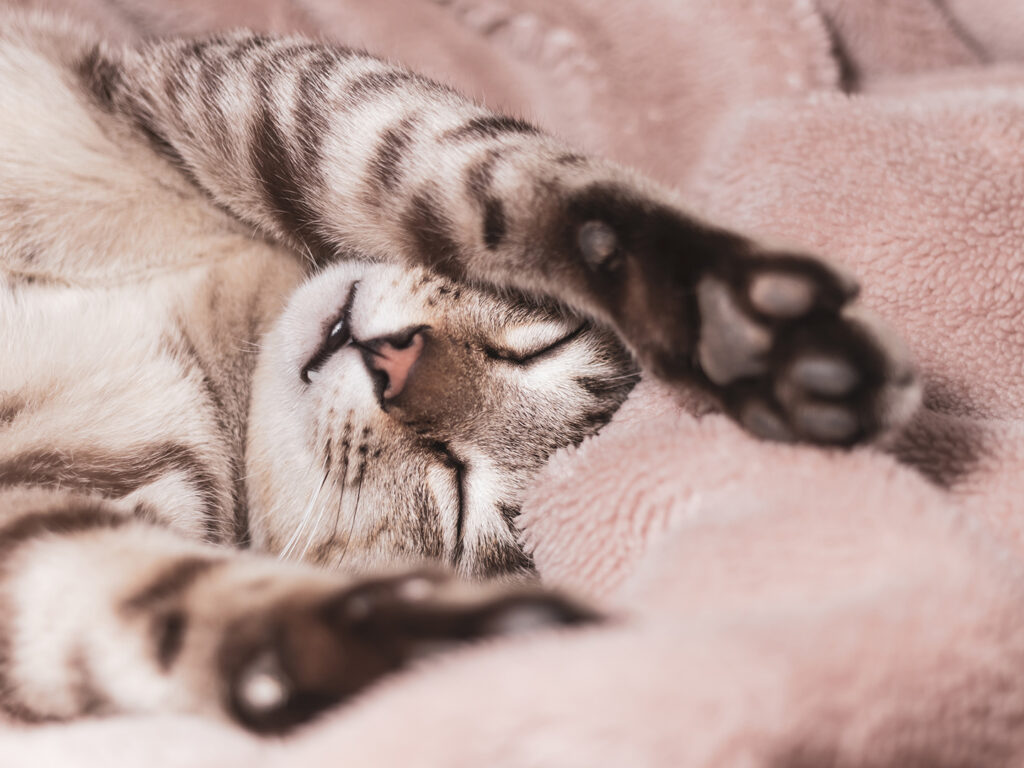Helping Cats Stand Up To Pillow Foot

A cat’s paw pads serve a variety of essential functions: they help regulate body temperature through sweat glands; provide traction so that cats can grip surfaces while they climb, jump, or run; and cushion each beautiful, fluid step a cat makes.
Paw pads can also reveal a lot about a cat’s health, as changes in how paw pads look or feel can be a sign that a cat has underlying health issues.
Dr. Christina Gentry, a clinical assistant professor in dermatology at the Texas A&M School of Veterinary Medicine & Biomedical Sciences, provides insight into pillow foot, an uncommon but serious condition that can affect paw pads and prevent cats from engaging in their daily activities.
Identifying, Confirming Pillow Foot
Feline pillow foot, also known as feline plasma cell pododermatitis, is a skin disease that causes a cat’s paw pads to become swollen and painful.
“Pillow foot occurs when high numbers of plasma cells, an immune cell that produces immunoglobulin to help fight infections and regulate the immune system’s response to the infection, infiltrate the tissue of the paw pads, yet the cause for this infiltration is unknown,” Gentry said. “Most cats feel well aside from the discomfort of their paw pads, although a small percentage may act sick with a fever or loss of appetite.”
Owners and veterinarians may notice if a cat has pillow foot by observing changes in the cat’s overall behavior and the appearance of their paws. The big pads of the paw are often affected the most, usually on more than one foot, but occasionally the small toe pads can develop swelling and sores as well.
“During routine interactions or when trimming the cat’s nails, owners may see that the larger pads are soft, squishy, or puffy — sometimes we describe them as feeling like bean bags — and have an open sore,” Gentry said. “In some cases, the first time an owner notices an issue is when the cat is lame, meaning they are less active or not jumping around as much. Other times their veterinarian will notice the swelling and any potentially open sores on the paw pads during physical exams.”
Because there are some conditions with similar symptoms to pillow foot, such as infections or autoimmune diseases, a proper diagnosis for pillow foot is necessary to ensure the cat receives the most effective and appropriate care for their condition.
“Often, pillow foot can be diagnosed during a physical exam if multiple paw pads have a sore or if there is a history of sudden lameness without any known trauma or other skin lesions,” Gentry said. “If the case is more subtle or owners want additional confirmation prior to starting treatment, a tissue biopsy can provide a definitive diagnosis. A fine needle aspirate, which involves poking a needle into the tissue and collecting cells to put on a slide for microscopic analysis, would also support the diagnosis if lots of plasma cells are present.”
What To Expect After Diagnosis
Once diagnosed, the specific treatment approach will depend on the individual cat’s condition and the severity of their symptoms, as more severe cases may require more intensive treatment.
“Oral immunomodulators, which are drug treatments to help regulate the body’s immune system, are the standard treatment and include doxycycline, an antibiotic with immunomodulating properties; and corticosteroids or modified cyclosporine to reduce inflammation,” Gentry explained. “In cases that do not respond to medical management, the pad tissue can be surgically removed.”
Intermittent or long-term treatment also may be necessary, so owners should be sure to follow their veterinarian’s advice closely. This includes attending follow-up appointments to manage their cat’s condition, monitoring their progress, and ensuring their comfort.
“Their veterinarian will slowly taper the immunomodulators and watch for flare ups, but if the condition returns or worsens as the medications are lowered, they may adjust the dose or change medication,” Gentry said. “Some cats require medication for one or two months, while others require an immunomodulator long term, ranging from a few months to a few years.”
With early detection, proper diagnosis, and an appropriate treatment plan for pillow foot, cats can step into a happy, healthy lifestyle, thanks to their owners and veterinary care team.
###
For more information about the Texas A&M College of Veterinary Medicine & Biomedical Sciences, please visit our website at vetmed.tamu.edu or join us on Facebook, Instagram, and Twitter.
Contact Information: Jennifer Gauntt, Director of VMBS Communications, Texas A&M College of Veterinary Medicine & Biomedical Sciences, jgauntt@cvm.tamu.edu, 979-862-4216


